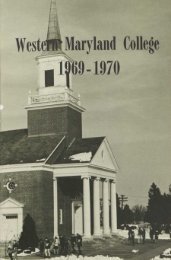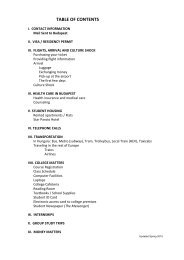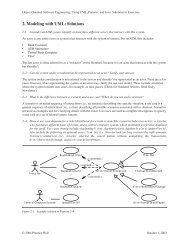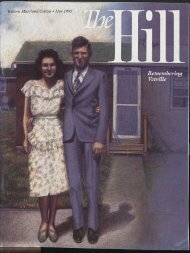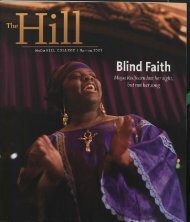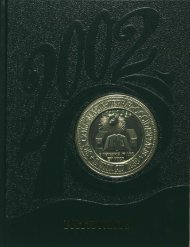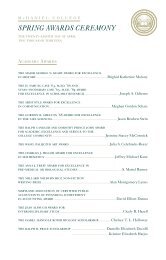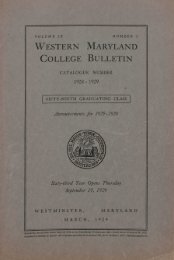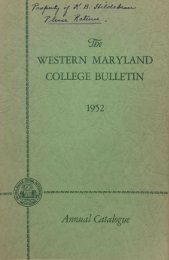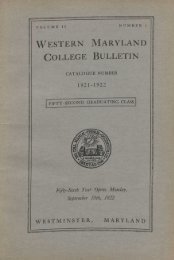Higher education'spatterns are changing;so are its leadersWhile only 11 percent of America's college graduateswent on to graduate work in 1950, about 25percent will do so after their commencement in1966. At one insti tution, over 85 percent of therecipients of bachelor's degrees now continue theireducation at graduate and professional schools.Some institutions, once regarded primarily as undergraduateschools, now have more graduate studentsthan undergraduates. Across America, another phenomenonhas occurred: numerous state collegeshave added graduate schools and become universities.There are also dramatic shifts taking place amongthe various kinds of colleges. It is often forgottenthat 877, or 40 percent, of America's colleges anduniversities are related, in one way or another, withreligious denominations (Protestant, 484; Catholic,366; others, 27). But the percentage of the nation'sstudents that the church-related institutions enrollhas been dropping fast; last year they had 950,000undergraduates, or only 18 percent of the total.Sixty-nine of the church-related colleges have fewerthan 100 students. Twenty percent lack accreditanon,and another 30 percent are considered to beacademically marginal. Partially this is becausethey have been unable to find adequate financialsupport. A Danforth Foundation commission onchurch colleges and universities noted last spring:"The irresponsibility of American churches in providingfor their institutions is deplorable. The averagecontribution of churches to their colleges is only12.8 percent of their operating budgets."Church-related colleges have had to contendwith a growing secularization in American life, withthe increasing difficulty of locating scholars with areligious commitment, and with bad planning fromtheir sponsoring church groups. About planning,the Danforth Commission report observed: IINo one~ag:;~~ti~:he operation of four Presbyterian. co 1 -fi . a, three Methodist colleges in Indiana,~e Umted Presbyterian institutions in Missouri,~tne Methodist colleges in North Carolina (includ-~:fl;w~ ~~~~new o.nes), and three Roman CatholicA;other i omen In Mi:waukee." .the chan in mpo.r~ant Shlf~ among the colleges I~r' g g POSItionof private institutions, as pubIas Institutions grow in size and number at a l11u che~S:~~I;~t~~In .1950, 50 percent of all students ~.... er:colle ' pfl~ate colleges; this year, the prt vat .h ges share IS only 33 percent. By 1975, fe,."e lt an 25 percent of all students are expected to be
y, but 15 years ago there were roughly 120,000Negroes in college, 70 percent of them in predominantlyNegro institutions; last year, according towhitney Young, Jr., executive director of theNational Urban League, there were 220,000 Negroesin college, but only 40 percent at predorninamlyNegro institutions.enrolled in the non-public colleges and universities.Other changes are evident: More and more studentsprefer urban colleges and universities to ruralones; now, for example, with more than 400,000students in her colleges and universities, America'sgreatest college town is metropolitan New York.Coeducation is gaining in relation to the all-rnen'sand the all-wornen's colleges. And many predominantlyNegro colleges have begun to worry abouttheir future. The best Negro students are soughtafter by many leading colleges and universities, andeach year more and more Negroes enroll at integratedinstitutions. Precise figures are hard to comeTREMARKABLE GROWTH in the number ofstudents going to college and the shifting patternsof college attendance have had great impact on theadministrators of the colleges and universities. Theyhave become, at many institutions, a new breedof men.Not too long ago, many college and universitypresidents taught a course or two, wrote importantpapers on higher education as well as articles andbooks in their fields of scholarship, knew most ofthe faculty intimately, attended alumni reunions,and spoke with heartiness and wit at student dinners,Rotary meetings, and football rallies, Nowmany presidents are preoccupied with planningtheir schools' growth and with the crushing job offinding the funds to make such growth possible.Many a college or university president today is,above all else, a fund-raiser, If he is head of a privateinstitution, he spends great amounts of timesearching for individual and corporate donors; if heleads a public institution, he adds the task of legislativerelations, for it is from the legislature that thebulk of his financial support must come.With much of the rest of his rime, he is involvedin economic planning, architectural design, personnelrecruitment for his faculty and staff and curriculumchanges. (Curriculums have been changingalmost as substantially as the physical facilities,because the explosion in knowledge has been assizable as the explosion in college admissions. Wholenew fields such as biophysics and mathematicaleconomics have sprung up; traditional fields haveexpanded to include new topics such as comparativeethnic music and the history of film; and topicsthat once were touched on lightly, such as Orientalstudies or oceanography, now require extendedtreatment.)To cope with his vastly enlarged duties, the mod-
- Page 1 and 2:
~~STERN MARYLAND COLLEGE I ~~o/ht~W
- Page 3 and 4:
TheWESTERN MARYLAND COLLEGEMagazine
- Page 5 and 6:
A Gift forthe CollegeCollectionBalt
- Page 7 and 8:
meat aU choice cuts. From this poin
- Page 9 and 10:
.'30to 40 miles for clinics on the
- Page 11 and 12: PAINT POSTSTHE CATALYSTPledges of G
- Page 13 and 14: On the Hit!New TrusteeArthur G. Bro
- Page 15 and 16: Hopkins TakesLast GameBasketball te
- Page 17 and 18: 19"Mrs. Otto Dieffenbach(Madeleine
- Page 19 and 20: Wayne Crackel! works for the YMCA i
- Page 22 and 23: The President's ColumnTribute toMan
- Page 24 and 25: Communication is many things; telep
- Page 26: period of old age, it might be cons
- Page 29 and 30: -- •Pagenine
- Page 31 and 32: Art is long they sayAnd the time is
- Page 33 and 34: Members of the Fund Committee meet
- Page 35 and 36: SPORTSClower's TearnHas TroubleUnli
- Page 37 and 38: During a recent dinner party at Car
- Page 39 and 40: SUpport equipment engineering divis
- Page 41 and 42: infant in March, 1964. She is also
- Page 43 and 44: portunity tool) StanleyHowell an El
- Page 45: cral science and biology.Thank you
- Page 48 and 49: Dasuet McCready, president of the W
- Page 50 and 51: The bridge is a symbol in literatur
- Page 52 and 53: Thi.s i.s one of th.e chemistry lab
- Page 54 and 55: Moberly wrote, "An honest intention
- Page 56 and 57: all sorts of odd jobs such as peddl
- Page 58 and 59: I".,"".'""""~ silentlv.unnoticej'~,
- Page 61: of scientists and engineers that ou
- Page 65 and 66: problems, and to international conf
- Page 67 and 68: DRA WINGS BY ARNO STERNGLASSconsequ
- Page 69 and 70: The students reactto "the system" w
- Page 71 and 72: The alumnilament: We don't Tecogniz
- Page 73 and 74: William S. Coffin, Jr.Campus Respon
- Page 75 and 76: SPORTSTERROR NINEIS DIFFERENTCoach
- Page 77 and 78: serving as interim Pastor of a smal
- Page 79 and 80: travel. The next newsletter will te
- Page 81 and 82: this summer. \Vhile there, they wil
- Page 83 and 84: The MagazineServiceCommencementCrec
- Page 85 and 86: TheWESTERN MARYLAND COLLEGEMagazine
- Page 87 and 88: Sally Reinecke chats with students
- Page 89 and 90: Thie is the Trapper Creek Job Corps
- Page 91 and 92: BOLIVIAPIONEER(S)by Joy Holloway, '
- Page 93 and 94: Joy says "Welcomethe right.to San P
- Page 95 and 96: '/'his article, printed in the May
- Page 97 and 98: June 6, 1966, Commencementpage-fift
- Page 99 and 100: DepartmentsGive HonorsTwenty-one me
- Page 101 and 102: y David Carrasco, '67RAIN HINDERSTE
- Page 103 and 104: ~~h:~~;~1i~~~lf. ft~l~~b/:~:~~:~n (
- Page 105 and 106: Nova Scotia, Gaspe Peninsula and Qu
- Page 107 and 108: Maryland National Guard's "Dandy Fi
- Page 109 and 110: Family Living at North Hagerstown H
- Page 111 and 112: the birth of their first child, Kei
- Page 113:
Andy was bam in the morning on the
- Page 117 and 118:
TheWESTERN MARYLAND COLLEGEMagazine
- Page 119:
AlumniFund Breaks RecordThis succes
- Page 122 and 123:
-,Martha O. VincentPaul F. W!L"'~r'
- Page 124 and 125:
11133-$997.00·"Webster M. Stray~rF
- Page 126 and 127:
*~~\~~:1}a{:~i~b1f5!~i~!;~~71~~Dryd
- Page 128 and 129:
1953-$804.45Ebie !l-laytrott Greenh
- Page 130 and 131:
·CornerstonepagesixteenOGCentutyCl
- Page 132 and 133:
·.\Iara Dil.on WalterSylvia A. Whi
- Page 135 and 136:
WESTERN MARYLAND COLLEGEOctober, 19
- Page 137 and 138:
TheWESTERN MARYLAND COLLEGEMagazine
- Page 139 and 140:
Introduction: the editorUNREST ON C
- Page 141 and 142:
form of prejudice involved in all s
- Page 143 and 144:
the adjustments toward college life
- Page 145 and 146:
To Catcha Fish byD,,;dLC.rrasco,'67
- Page 147 and 148:
"WMC Curriculum: Overstructured and
- Page 149 and 150:
New Look for Religious Organization
- Page 151 and 152:
vocational requirements in preparat
- Page 153 and 154:
SPORTSSidelineWoreby David Carrasco
- Page 155 and 156:
seeLos Angeles for part of the summ
- Page 157 and 158:
John Z. Dlsh, 28 Westmoreland Stree
- Page 159 and 160:
college president). Bill and his wi
- Page 161 and 162:
(that's what she wrote!), Clair/! M
- Page 163 and 164:
Harry has been a member of the Boar
- Page 165 and 166:
call as he would be happy to share
- Page 167 and 168:
is serving a 12-month tour with the
- Page 169:
MAY DAY 1966




